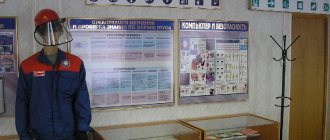Definition of the concept
Safety precautions are a set of organizational and technical measures that are needed to create safe working conditions and that prevent industrial accidents. She determines the internal organizational routine and is responsible for ensuring that the process of conducting professional activities is as trouble-free as possible. At factories and in other organizations, to solve problems, entire services are organized under the department of the chief engineer, developing measures aimed at ensuring safe operating conditions.
Prohibition sign and safety precautions: you can’t do this
It is mandatory to systematically carry out specialized measures aimed at reducing the risk of injury and eliminating the likelihood of industrial accidents. Such activities boil down mainly to:
- improvement and modification of the designs of existing equipment to protect employees from injury;
- installation of new, modification of old designs of existing protection devices for machine tools, machines, heating installations;
- improvement of working conditions - creation of sufficient lighting, ventilation system, arrangement of dust extraction, timely elimination of production waste, maintaining optimal temperature inside the workshops;
- eliminating the risks of developing emergency situations during equipment operation, breaking grinding wheels, minimizing the risks of acid splashing, etc.;
- organized briefing of newcomers regarding the rules of behavior on the territory of the enterprise, training, testing of knowledge;
- provision of TB instructions and posters in sufficient quantities.
Accidents are still possible, largely due to workers ignoring the safety precautions for operating power plants, electrical installations, and other equipment. The relevant issues should be covered by the responsible person during the scheduled briefing. Physically outdated facilities should undergo regular inspections and updates. Responsible specialists monitor compliance with the system of rules and regulations - they are the ones who must teach the basics of proper work.
Important! Particular caution is needed in construction and areas with other high risks.
Workers who deal with welding stations, solvents in production, and other dangerous tools and materials must have an appropriate knowledge base on the practice of conducting basic operations.
Distribute occupational safety responsibilities
The distribution of responsibilities in the field of labor protection between officials in a standard situation is called ensuring the functioning of the OSMS .
Document the duties and powers of each employee within the OSMS in local regulations and employment contracts. If this is not done, all responsibility will fall solely on the occupational safety specialist.
Make a list of all labor safety responsibilities of the enterprise, and distribute responsibilities by area of activity.
Issue an order to those responsible at each level of management. The HR officer is responsible for training in occupational safety and health, heads of structural departments are responsible for risk management at their sites, auditors are responsible for checking the occupational safety and health system at the enterprise, authorized persons are responsible for planning measures to improve the safety and health system, employees are for fulfilling occupational safety requirements and proposals for improving the occupational safety and health system. .
The labor protection specialist is responsible only for coordinating and monitoring the implementation of labor protection work (see the professional standard of the labor protection specialist).
According to Art. 212 of the Labor Code of the Russian Federation, in general, the employer is responsible for organizing work. In turn, the employer distributes these labor protection responsibilities among services in accordance with the organizational level.
The levels of management can be considered the level of the production team, the level of the production site, workshop, branch, service or employer as a whole.
Therefore, the occupational safety specialist, together with senior employees, needs to outline the responsibilities for occupational safety for the heads of structural units at the relevant levels, and for the workers themselves.
Each head of a structural unit must be responsible for the safety of his employees!
Industrial labor protection
Occupational health and safety at ATP
Occupational health and safety at an enterprise is a set of measures necessary to ensure minimal risk conditions for workers’ activities. System directions:
- cable lines, electrical equipment, power lines, lightning protection;
- prevention of fires and smoke;
- safe performance of work of various categories;
- maintaining equipment in good condition;
- maintenance of the territory and buildings;
Poster about safe work, health and life
- neutralization of the negative influence of vibrations, noise, dust;
- protecting people working in hazardous conditions;
- personnel training (regular briefings in the organization);
- tracking employee health indicators;
- public monitoring of general TB at the enterprise.
Note! Labor protection and safety standards at the enterprise regulate the activities of organizations taking into account internal OSH standards.
The information required by employees regarding the safe performance of work is prescribed in safety instructions, as a rule, for each profession separately.
How is labor protection organized at the enterprise by management?
Occupational safety management system in the organization:
The head of the organization determines the structure of the labor protection service and its number depending on the number of employees, the nature of working conditions, the degree of danger of production and other factors. At the same time, he is guided by recommendations for organizing the work of the occupational safety service at the enterprise, approved by Resolution of the Ministry of Labor of the Russian Federation No. 14 of 02/08/2000, as well as inter-industry standards approved by Resolution of the Ministry of Labor of the Russian Federation No. 10 of 01/22/2001 “On approval of Inter-industry standards of headcount workers of labor protection service in organizations"
” Who does the labor protection service report to?
The labor protection service reports directly to the head of the organization or his deputy.
When organizing labor protection at an enterprise, first of all, the manager should determine who will perform the function of a labor protection specialist: a separate structural unit, a labor protection specialist, the manager himself, a person authorized by him or a third-party organization.
In an organization with an average number of employees of up to 700 people (in the absence of workers employed in harmful and dangerous working conditions), it is enough to have a separate labor protection specialist. In organizations with larger numbers, a labor protection service is created, consisting of three or more employees. The number of people in the labor protection service is given in the standards.
Organization of labor protection from scratch step by step when creating an occupational safety service:
1. The manager signs an order to create a labor protection service.
2. It is necessary to determine to whom the labor protection service in the organization reports. (In almost all cases, the labor protection service reports to the head of the organization or his deputy).
3. It is imperative to make a change to the staffing table if the labor protection service or specialist position was not provided for by it.
4. Next, it is necessary to develop a regulation on the labor protection service, which should spell out the goals and objectives of the service, rights and responsibilities, the procedure for interaction with other departments, etc.
5. Also, a mandatory condition for organizing labor protection is the presence of job descriptions. They need to be developed. These instructions on the organization of labor must be developed in accordance with the Unified Qualification Directory of Positions of Managers, Specialists and Employees, section “Qualification Characteristics of Positions of Specialists Carrying Out Work in the Field of Labor Safety,” approved by Order of the Ministry of Health and Social Development of the Russian Federation No. 559n dated May 17, 2012 year, as well as the Professional Standard for Occupational Safety and Health Specialist 524n.
Order No. ... on the creation of a labor protection service In order to organize work on labor protection in accordance with Art. 217 Labor Code of the Russian Federation
I ORDER: 1. To create a structural unit in the organization - “Occupational Safety and Health Department” with 2 staff units: - head of the labor protection department - 1 staff unit; – occupational safety specialist – 1 staff unit. 2. Make appropriate changes to the staffing table. 3. To the head of the HR department Ivanova L.I.: 3.1. Prepare changes to the staffing table and send it for approval within… 3.2. Develop Regulations on the Occupational Safety and Health Service and job descriptions for employees of the Occupational Safety and Health Department within .... 3.3. Submit proposals for staffing the service with employees of the required qualifications within… 4. I reserve control over the execution of the order.
Director Kovalev A.A. The order has been reviewed by: Head of the HR Department Ivanova A.I.
The head of the organization may not create an entire department or hire a labor protection specialist, but by his order assign the duties of the specialist to another employee of the organization as a part-time worker. By law, he has the right to do this if his organization has fewer than 50 employees. In this case, the position of a labor protection specialist must be provided for in the staffing table.
Order No. ... on assigning the duties of a labor protection specialist in the order of combining positions
I ORDER: 1. Assign the duties of a labor protection specialist in accordance with the staffing table on the basis of combining positions in accordance with Part 2 of Art. 60.2 of the Labor Code of the Russian Federation for Deputy Director for Administrative and Economic Affairs Petrov I.V. 2. Chief accountant Matushkina E.I.: establish I.V. Petrov received a monthly additional payment for performing additional work in order to combine positions in the amount of 12,000 rubles. 3. Send I.V. Petrov to study at the Regional Educational and Methodological Center of BSTU named after. Shukhova. 4. Head of the HR Department Ivanova A.I.: prepare an agreement with the RUMC BSTU named after. Shukhov for training I.V. Petrova. 5. I.V. Petrov: begin performing duties as an occupational safety specialist the next day after completing the occupational safety training. Reason: additional agreement to the employment contract dated. N...
Director Kovalev A.A. The order has been reviewed by: Chief Accountant E.I. Matushkina Head of HR Department A.I. Ivanova Deputy Director for Administrative and Economic Affairs I.V. Petrov
When working part-time, an employment contract is concluded with the employee, and the work is performed in free time from the main job (Article 60.1 of the Labor Code of the Russian Federation). When working on a part-time basis, work is performed during the established duration of the working day (shift) along with the work specified in the employment contract, with the written consent of the employee (Article 60.2 of the Labor Code of the Russian Federation). When combining positions, an additional agreement to the employment contract is concluded with the employee. Before signing an employment contract or additional agreement with an employee, it is necessary to familiarize the occupational safety specialist with the job description and other local regulations in the field of occupational safety, against signature.
The occupational safety management system in an organization with less than 50 people is as follows. If the head of an enterprise (individual entrepreneur) with less than 50 employees assigns the responsibilities of a labor protection specialist to himself, no order needs to be issued, since he is already obliged to ensure safe conditions and labor protection in the organization (Article 212 of the Labor Code of the Russian Federation). In addition, managers, along with labor protection specialists, undergo special training on labor protection for managers and specialists within the scope of their job responsibilities upon entering work during the first month, then as necessary, but at least once every three years.
Newly appointed managers are allowed to work independently after they have been familiarized by the employer (or a person authorized by him) with job responsibilities, including labor protection, local regulations in force in the organization that regulate the procedure for organizing work on labor protection, and working conditions in the areas entrusted to them. objects (in structural divisions of the organization) (clause 2.3.1 of the Procedure).
Why should you follow safety precautions in the workplace?
Occupational safety and health at school: instructions and safety precautions
The main reason for the urgent need for strict adherence to safety regulations is to minimize the risk of injury during the production process. But there are other reasons, let’s name them:
- protecting the health and life of the employee, preventing disability;
- probable damage to third parties;
- failure to provide guarantees and benefits (for example, deprivation of 13 salaries for violation of discipline);
- deterioration in the quality of services and products;
- dismissal at the discretion of the employer.
Important! At least 2 thousand people die every year in production facilities in the Russian Federation, and 4 thousand become disabled. The reason is non-compliance with safety regulations.
Preparation of training programs
The educational process is impossible without properly developed instructions and training programs relating to each profession and type of work performed. Ready-made programs can be purchased from companies that compile them.
Ready-made training programs on labor protection
Employees’ knowledge is tested using ready-made training programs, after which an inspection protocol is drawn up. Employees must undergo training annually or every time there is a change in profession, position, after a transfer or break in work. Management is retrained once every 3 years.
Responsible persons
Occupational health and safety in hot and cold workshops
The safety of workers, in addition to themselves, must be taken care of by the security service and the employer.
What an employer must
A superficial acquaintance with occupational safety and health may lead to the idea that the occupational health and safety engineer is responsible for the safety of employees. This is not true - the main responsible person will be the immediate supervisor. The corresponding responsibilities are assigned to management at different levels - departments, divisions, enterprises.
OT service
The OT service is organized specifically to solve problems such as:
- conducting investigations, analyzing the causes of accidents;
- creation and implementation of programs and activities aimed at improving working conditions;
- organizational, methodological support;
- participation in knowledge testing;
Security service guarding the rules
- assistance in preparing papers on occupational health and safety issues;
- compiling lists for the provision of food, protective clothing, payment of benefits, and undergoing regular medical examinations;
- preparation and submission of reports;
- storage of documentation;
- organization of training;
- regular inspections of the health status within departments;
- conducting introductory briefings.
Service specialists have the right to inspect premises, equipment and machinery at any necessary time, look at documents, and monitor the process of work performed by workers.
Important! To successfully solve current problems, OT specialists cooperate with various enterprise services, commissions, and trade unions.
Who monitors the services?
Occupational safety specialists report to the head or deputy head of the company in which they work. Representatives of third-party organizations are required for professional monitoring of the quality of performance of duties. These include departmental, state, non-departmental, and public bodies. Inspections are carried out as planned, and the OT service is properly notified of the activities provided.
Organization of work on labor protection in an organization in accordance with Russian legislation
The organization of labor protection work in the organization is the responsibility of the employer. He is obliged to provide workers with safe working conditions that meet state requirements (clause 4, part 2, article 22, article 212 of the Labor Code of the Russian Federation). The main directions for organizing work on labor protection in an organization are established in Chapters 33-36 of the Labor Code of the Russian Federation and Recommendations for organizing the work of the Labor Safety Service in an organization, approved by Resolution of the Ministry of Labor of Russia dated February 8, 2000 No. 14. Organization of work on labor protection in an organization is preparation, adoption and implementation of decisions in order to ensure life safety, preserve the health and performance of workers in the process of work.
1. The organization of work on labor protection in an organization begins with the approval of the Regulations on the organization of work on labor protection. If the organization has more than 50 people, the employer creates a labor protection service or introduces the position of a labor protection specialist (Part 1 of Article 217 of the Labor Code of the Russian Federation). The employer develops regulations on the creation and operation of a labor safety management system in the organization.
2.Organization of work on labor protection in an organization involves training workers in safe methods and techniques for performing work and providing first aid to victims at work (Part 2 of Article 212 and Article 214 of the Labor Code of the Russian Federation).
Work on labor protection includes conducting labor safety briefings with employees, organizing their internships in the workplace and testing their knowledge of labor protection requirements.
This work includes:
- Conducting introductory briefing on labor protection (with registration in the registration log of introductory briefing in the established form);
- conducting initial briefings on labor protection with registration of internships,
- conducting repeated, targeted, unscheduled briefings on labor protection (with registration in the log of registration of briefings);
- development of a program for conducting initial training in the workplace;
- development of a list of professions and positions of workers exempt from initial and repeated briefings at the workplace;
- development of a list of questions, a program for conducting introductory briefings on labor protection;
- development of a list of positions for those managers and specialists who must undergo knowledge testing on labor protection issues;
- development of a list of working professions that must undergo an internship before being allowed to work independently;
- execution of an order from the head of the organization to create a commission (commissions) to test workers’ knowledge on labor protection issues (all members of the commission and the chairman of the commission are required to undergo a knowledge test on labor protection issues themselves);
- development of a training program on occupational safety issues;
- development of exam questions to test knowledge on labor protection issues;
- development of a schedule for testing knowledge on labor protection issues;
- drawing up minutes of the meeting of the commission for testing knowledge on labor protection issues;
- making entries on the examination of knowledge on labor protection in the certificates of the established form.
- 3. The employer organizes mandatory medical examinations of the organization’s employees (preliminary – upon hiring, periodic – during the period of work). This work includes:
- development of a list of persons required to undergo periodic medical examinations;
- development of a schedule for medical examinations;
- issuing an order to ensure the passage of a medical examination;
- development of an action plan to improve working conditions in the organization;
- development of a list of works for which medical examinations are required.
4. The employer is obliged to organize the development and approval of labor protection instructions for employees, taking into account the opinion of the elected body of the primary trade union organization. This work includes:
- development (taking into account the staffing table) of a list of labor protection instructions, which is approved by the head of the organization;
- development and approval by the head of the organization of labor protection instructions for professions and types of work. The instructions must be agreed upon with the labor protection engineer and signed by the head of the structural unit;
- registration of labor protection instructions in the log of labor protection instructions;
- keeping records of the issuance of labor protection instructions in the journal for recording the issuance of labor protection instructions.
5.Planning of occupational safety measures, namely:
- development of a labor protection action plan;
- approval of cost estimates aimed at labor protection measures.
6.The employer is obliged to provide the organization’s employees with personal protective equipment (PPE). This work includes:
- developing a list of professions, as well as categories of workers who are issued PPE;
- execution by the responsible person of timely applications for the receipt of workwear (indicating the size of clothing and shoes);
- keeping records of the issuance of PPE (personal PPE accounting cards).
7.The employer is obliged to ensure that a special assessment of working conditions is carried out. This work includes:
- issuing an order from the head of the organization to create a commission for a special assessment of working conditions;
- drawing up a list of workplaces subject to special assessment of working conditions;
- concluding a civil contract with an organization conducting a special assessment of working conditions;
- identification of potentially harmful and (or) dangerous production factors;
- testing (research) and measurement of harmful and (or) hazardous production factors;
- registration of special assessment cards for working conditions;
- drawing up a protocol of the organization’s commission on the completion of work on a special assessment of working conditions;
- report on the results of a special assessment of working conditions;
- drawing up a list of jobs for those professions and positions for which employees, based on the results of a special assessment of working conditions, have been confirmed the right to additional leave for work with harmful and (or) hazardous production factors;
- drawing up a list of jobs for those professions and positions for which workers, based on the results of a special assessment of working conditions, have been confirmed to have the right to additional payments for working with harmful or dangerous production factors;
- development and execution of an action plan to improve working conditions.
8. The employer is obliged to provide sanitary and consumer services to employees in accordance with labor protection requirements. This includes:
- providing employees of the organization with sanitary facilities and maintaining them in good condition;
- proper operation of supply and exhaust ventilation systems;
- maintaining a log of equipment repair and operation;
- development of a schedule for inspections, cleaning, and repair of the ventilation system;
- ensuring normal illumination of workplaces.
9. The employer is obliged to ensure the organization of control in the organization over the state of working conditions in the workplace. This work includes:
- drawing up instructions on monitoring compliance with labor protection legislation in the organization;
- keeping by responsible persons a log of daily monitoring of the state of labor protection;
- keeping by responsible persons a journal of administrative and public control over the state of labor protection;
- drawing up a report on quarterly monitoring of the state of labor protection in the organization, indicating the detected deficiencies and measures to eliminate them;
- issuing an order from the head of the organization to hold Occupational Safety Day with the appointment of a commission to hold Occupational Safety Day;
- issuing an order from the head of the organization on the state of labor protection in the organization as a whole.
10.Investigation and recording of industrial accidents. This work includes:
- execution of an order from the head of the organization to appoint a commission to investigate industrial accidents;
- preparation of materials for the investigation of an industrial accident (explanatory statements from the victim and witnesses, medical reports on the nature and severity of the injury, the causes of death of the victim, as well as whether the victim was under the influence of alcohol, drugs or toxic substances);
- drawing up a report on an industrial accident, form N-1;
- registration of the fact of an industrial accident in the accident register;
- development of an action plan to eliminate violations that led to the accident;
- drawing up a report on a non-production accident in the NP form;
- maintaining a log of non-production accidents;
- execution of an order from the head of the organization to carry out measures to eliminate the causes of the accident, bringing to justice those who committed violations;
- keeping a log of microtraumas
11.Organization of work to ensure electrical safety in the organization. This work includes:
- issuing an order from the head of the organization to appoint a person responsible for electrical equipment;
- issuing an order from the head of the organization to conduct a knowledge test of non-electrical personnel to assign electrical safety group I;
- development of a list of positions and professions requiring assignment to non-electrical personnel of group I in electrical safety;
- development of a list of positions and professions that require assignment to electrical engineering personnel of the appropriate electrical safety group;
- registration of acts of acceptance (admission) of electrical installations into operation;
- control of the availability of technical passports of main electrical equipment, buildings and facilities, certificates for electrical equipment;
- development of operating instructions for electrical installations;
- monitoring the availability of protocols for checking the insulation resistance of wires, cables and grounding devices;
- monitoring the availability of power supply circuits;
- registration and maintenance of protective equipment in the logbook of accounting and maintenance of protective equipment; registration of a test log of protective equipment made of electrically insulating and polymeric materials;
- preparation of test reports for protective equipment for protective equipment belonging to third-party organizations;
- registration of a safety knowledge test for personnel with electrical safety group I in the journal for testing safety knowledge for personnel with an electrical safety group
12.Providing compensation for work with harmful and (or) dangerous production factors. This work includes:
- receiving additional payments for work with harmful and (or) dangerous production factors (based on the results of a special assessment of working conditions);
- provision of additional leave for work with harmful and (or) dangerous production factors (based on the results of a special assessment of working conditions);
- development of a list of those professions and categories of workers employed in production, workshops, sections, other structural units, in jobs that give the right to be provided with milk or equivalent food products;
- development of a list of professions and positions of enterprise employees that are provided with flushing and neutralizing agents.
13. The procedure for organizing high-risk work in the organization. This work includes:
- development of a list of professions of workers performing work with increased danger, the performance of which requires testing of knowledge on labor protection issues;
- development of a list of high-risk work performed under a work permit;
- registration in accordance with the established form of the permit;
- provision of necessary PPE before performing work;
- admission to perform high-risk work for a certain category of employees of the organization (male with no medical contraindications, at least 18 years old, with sufficient experience, able to provide first aid).
14. Organization of work to ensure fire safety, including:
- issuance of an order from the head of the organization on the appointment of a fire safety regime in the organization;
- issuance of an order from the head of the organization on the appointment of persons responsible for fire safety;
- development of facility-wide instructions on fire safety issues;
- design of visual propaganda, fire safety corners;
- maintenance of primary fire extinguishing equipment;
- scheduled inspection of primary fire extinguishing equipment, timely recharging of fire extinguishers;
- timely conduct of fire safety briefings (introductory, primary, targeted, unscheduled);
- issuing an order from the head of the organization on the creation of voluntary fire brigades;
- development of an action plan to ensure fire safety;
- development of evacuation plans for workers and material assets in case of fire;
- registration of work permits for hot work in accordance with the established form;
- keeping a log of hot work registration.
15. Informing workers about labor conditions and safety in the workplace. Creation of corners and offices for labor protection.
On the issue of organizing work on labor protection of organizations in accordance with Russian legislation, presentation by Valery Anatolyevich Korzh, Director of the Department of Labor Conditions and Labor Safety of the Ministry of Labor and Social Development of the Russian Federation.
Each organization must develop a set of regulatory legal acts on labor protection. These local regulatory and legal acts are the direct basis for the management and functioning of the labor protection system in the organization.
If the information was useful, leave comments and share the link to this article on your social networks. Thank you!
More articles:
An approximate list of documentation on labor protection of an organization.
REGULATIONS on the organization's labor protection corner
Unscheduled briefing on labor protection
Planning the work of a trade union organization
Instructions
Basic requirements for TB:
- when starting to perform each type of work that has not been done before, additional instruction is needed;
- extreme attentiveness is required, it is not recommended to be distracted by extraneous conversations or affairs;
- On the territory of the plant you cannot walk around the workshops, ignore the signals of crane operators and vehicle drivers. It is imperative to bypass unloading and loading areas, and bypass places not intended for passage. You cannot touch terminals, electrical wires, equipment, fittings, lighting devices, especially with tools or scissors;
- In case of injury or any ailment, the injured person needs to stop the work process and seek medical help.
Workers perform various operations at the site
Before starting to perform direct work duties, employees must get their uniform in order, put on personal protective equipment, if necessary, and special shoes. You should also inspect the workplace, restore order, and remove unnecessary items. There should be enough light, but not blinding to the eye, it should be directed towards the work area.
It is necessary to inspect the floor - there should be no potholes, slippery areas or other defects. Hoists and hoists can only be used in good working order. When moving or lifting heavy loads, the signal must be given by one worker. The slinging is made reliable; high-strength cleats are used for mooring.
Sharpening tools on grinding wheels can only be done by first wearing safety glasses. There is a protective screen; it should not be moved to the side. Be sure to check that the tool rest is installed correctly and bring it as close to the grinding wheel as possible. You need to stand half a turn towards the wheel while sharpening. You cannot remove chips by hand.
Plan OHS improvements
Planning for improvements in the functioning of the OSMS takes place at least once a year.
Important requirements for the effective functioning of the Occupational Health and Safety Management System at the enterprise are specified in GOST 12.0.230.2-2015 “Occupational Safety and Health Management Systems”.
To assess the effectiveness of the occupational safety and health system, use all possible information in the field of occupational safety and health at your enterprise (reports of audits of occupational safety and health systems, accidents, occupational diseases, instructions for inspections by the labor inspectorate, analytical reviews of the industry, the experience of other organizations, etc.).
Based on the results of the analysis of the effectiveness of the occupational safety and health management system, draw up a report in which you plan measures to improve the occupational safety management system.
Briefing: types, how it is carried out
The first type of instruction is introductory. It is carried out for all new employees, regardless of length of service or level of education. Travelers, temporary workers, students, students undergoing internships should know the instructions. A complex of knowledge necessary for work is mastered.
Important! Certain categories of persons may be exempt from instruction. Their lists are compiled by management.
The next type of instructions is the primary one in the workplace. It is carried out for all new employees, including those who work under the terms of a short-term employment contract and are hired seasonally. Primary instructions are needed for business travelers and employees transferred from one unit to another within the organization. They introduce technologies, equipment, features of preparation for performing work duties, requirements for clothing, footwear, and personal protective equipment. The instruction also covers issues of first aid and responsibility for ignoring TB. It is carried out by the head of a specific type of work in computer science classrooms, directly at workplaces, and in other equipped premises.
After initial instructions, the employee undergoes an internship for 2-14 shifts, during which time his activities must be supervised by a responsible specialist. When the internship is completed, a review is carried out. All entries are entered into a journal.
Why is it important to follow instructions?
The third type of instruction is repeated. It is taken by workers with any experience, education, or skill level. The minimum frequency is every six months. Responsible person, teacher - work manager. Lesson programs developed specifically for these purposes are used.
Unscheduled OT briefing is the fourth type. It is needed when introducing revised or completely new rules, standards, or after changes in technological processes. If employees violate labor safety requirements, unscheduled instructions are also mandatory. The implementation of measures may be required by officials of control and state supervision bodies.
The last type of briefing is targeted. They are introduced when performing one-time work not related to the direct duties of specialists, to eliminate the consequences of disasters, natural disasters, and accidents. Other reasons are excursions, organization of public events at the plant, in the company. You must act in accordance with the regulations.
Organization of personnel training
All individuals working in the organization are required to periodically pass an occupational safety exam. To this end:
- general briefings are conducted for all employees who have just joined the company (one time);
- special briefings (once a year) for certain categories of employees (regularly).
In total you need to go through 5 types of instructions:
- introductory (when applying for a job);
- primary (conducted by the head of the structural unit);
- repeated (once every 3 months);
- target (if the technician needs to perform a specific job);
- unscheduled (if required by the inspector).
If necessary, employees of the organization are sent to OT training. After conducting the briefing and passing the safety knowledge (HS) exam, employees sign in the logbook for registering the briefing.
Important! 40 hours are allocated for training a manager, and at least 20 hours for training ordinary workers.
Magazines
In accordance with current legislation, logs for registering briefings at workplaces are filled out in accordance with the established form. They record all types of work performed. The employer monitors the availability and correctness of the document. If there is no log, employees of regulatory authorities may accuse management of non-compliance with labor safety rules.
Important! The journal is certified by the responsible person. The type of document production is typographic.
The filling form is used uniformly for all divisions of the company. The forms are kept by an engineer or other responsible employee. The specialist who conducts the instructions can take the log from the occupational safety engineer. The pages of the document are numbered, laced, and stamps are required.
Labor protection 2021 – 2021: new rules
The labor protection legislation was amended in 2021. One of the main changes to the labor protection rules 2021 is the introduction of assessment of professional qualifications in the form of a professional exam, which is conducted by specialized centers. Compliance of qualifications with professional standards can be at the initiative of both an individual and an employer.
Another innovation is the new GOST standards on labor protection from 2021. Additional requirements for physical factors in the workplace are established by the new SanPiN 2.2.4.3359-16. The document lists standards for illumination, vibration, electromagnetic fields, microclimate, noise, radiation, ultra- and infrasound. Non-compliance with standards and the presence of harmful factors can be identified in the process of conducting a special assessment of working conditions.
In addition to SanPiN 2.2.4.3359-16, other regulations on labor protection – 2021 have been adopted:
- Organization of occupational safety training - GOST 12.0.004-2015;
- Hazardous and harmful production factors - GOST 12.0.003-2015;
- Signal colors, safety signs and signal markings - GOST 12.4.026-2015;
- Occupational safety management system - GOST 12.0.230.1-2015, GOST 12.0.230.2-2015.
Changes in labor protection in 2021 also affected micro-enterprises. Now they may not have to draw up internal labor regulations, wage regulations, bonus regulations, or shift schedules. All issues that are usually enshrined in local acts can be included in employment contracts. Microenterprises can conclude agreements on the basis of the standard form from the Decree of the Government of the Russian Federation dated August 27, 2016 No. 858.
Another amendment to the labor protection rules in 2021 - the Social Insurance Fund will reimburse costs only for personal protective equipment manufactured in the Russian Federation from Russian fabrics, knitted fabrics, and non-woven materials.
Responsibility in case of violation of rules
According to the law, labor protection and safety regulations in production must be strictly observed.
Industrial safety precautions must be observed
Penalties in case of violation:
- disciplinary - reprimands, dismissals; no more than six months must pass from the moment the act was committed to be held accountable;
- administrative - provided for inaction or illegal actions, regulated by the Code of Administrative Offenses, and involves the imposition of fines;
- material – the basis is actual damage caused by the employee;
- Criminal is the most complex and strict option; it involves persons whose actions have led to serious health problems or deaths at work.
Compliance with safety regulations at work causes risks when conducting professional activities. Regular briefings are mandatory; management and authorized representatives (OT service) are responsible for the execution of work.
What is the responsibility for violations in labor protection organizations?
If the head of an enterprise has not taken measures to train employees in occupational safety standards, he is responsible for this before the law.
Criminal liability
This type of liability occurs if an accident occurs at the enterprise due to non-compliance with safety regulations, and the person responsible is caught in it. They are held accountable under Art. 143 of the Criminal Code of the Russian Federation. The culprit of the incident is punished depending on the degree of guilt and the harm caused. The court has the right to fine the guilty person in the amount of up to 400 thousand rubles*, send him to forced, compulsory or correctional labor, and restrict freedom for up to 1 year (possible loss of license for the same period).
If people died, the term of imprisonment is increased to 4 years, and the period of disqualification to 3 years.
Administrative responsibility
They are brought to administrative responsibility under Art. 2.4 and art. 5.27 Code of Administrative Offenses of the Russian Federation. Responsible persons are fined or forced to cease activities until all labor safety problems discovered by the inspector are eliminated.
The legislative framework
Set up document flow according to the OSMS
In order to organize the document flow on OSHS in an organization, we are guided by Order 77 “Methodological recommendations of OSHS”. The rules indicate that persons responsible for the development of labor protection documents are determined at all levels of management.
Determine the rules by which documents are developed, their approval, approval, revision, and storage periods.
Maintain a database of OSMS documents, both in paper and electronic form. Organize them into folders for easy searching.











